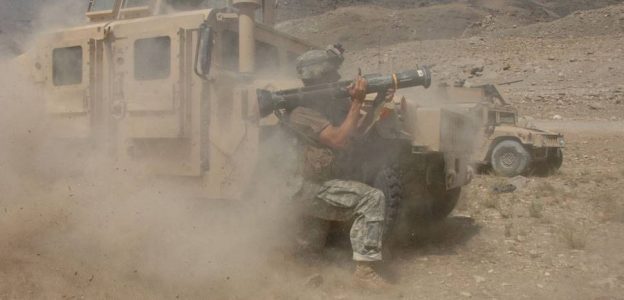
How the Islamic State terrorist group fractures the Afghanistan’s peace prospects?
The so-called Islamic State is successfully undermining US-led peace prospects in Afghanistan. On May 12, the president of the US-backed government, Ashraf Ghani, ordered security forces to pivot from a defensive to offensive stance on the Taliban and other adversaries. This is exactly what ISIS-K, the so-called Islamic State’s branch in Afghanistan, wants to see.
ISIS-K hopes to divide Ghani’s government, the Taliban, and the United States as much as it can following peacebuilding measures set in late February between the Taliban and United States. An Afghan peace agreement could potentially end over 30 years of conflict, paving a promising future for Afghanistan. February’s agreement strengthened confidence between the U.S. and Taliban insurgents, ultimately seeking dialogue between the Taliban and Ghani’s government.
Both the Taliban and Afghan government regularly combat ISIS-K, and a bilateral peace agreement among its adversaries could spell disaster for ISIS-K’s operations in Afghanistan. So, ISIS-K embarked on a three-pillared strategy to upend the peace agreement: attacking non-Sunni Muslim civilians, the Afghan government and the Taliban, and U.S. military bases in Afghanistan.
ISIS-K’s attacks on non-Sunni populations sever the trust between the Afghan government and the Taliban, leading to infighting and weakened peace prospects. On March 25, gunmen and suicide bombers killed 25 worshippers in a Sikh religious complex in Kabul. According to ISIS-K, the attack was “retaliation” for India’s treatment of Muslims in Kashmir, but the attack created larger implications for the Afghan government.
Ghani’s government appeared weak and unable to govern its capital, so the Taliban attacked Afghan security forces a few days later. Following ISIS-K’s attack, relations between the Taliban and the Afghan government worsened. On May 12, ISIS-K claimed another attack on a funeral in Nangarhar province which killed 24 civilians. The same day, an attack on a Kabul maternity ward orphaned 18 newborn babies.
The U.S. special envoy to Afghanistan blamed ISIS-K for the attack, citing a US-led investigation, but Afghan government officials claimed that the Taliban was responsible. Whether or not ISIS-K launched the attack on the maternity ward, its divisive strategy culminated in the Afghan government’s call for offensives against the Taliban, which incited a Taliban retaliatory attack on an Afghan military base two days later. ISIS-K’s continued attacks on non-Sunni civilian populations erodes trust between the Afghan government and the Taliban while weakening public faith in a peace deal.
ISIS-K’s attacks on the Afghan government and the Taliban, two of the most powerful factions in Afghanistan, haven’t unified them against a mutual adversary. Along with attacking non-Sunni civilian populations, ISIS-K’s direct attacks on Taliban and Afghan forces make Sunni Muslim populations in Afghanistan question the legitimacy of ISIS-K’s adversaries.
On March 9, ISIS-K rocket fire interrupted President Ghani’s inauguration, creating an immediate sense of insecurity for the Afghans. Two months later, in May, ISIS-K claimed responsibility for “back-to-back” blasts on Afghan convoys in a search for a high-ranking Afghan intelligence official. These attacks continue to succeed and divide the Afghans and the Taliban despite ISIS-K being dealt significant setbacks, including the reported arrests of the Afghan and South Asian affiliate branch leaders.
The Taliban, on the other hand, engages ISIS-K in rural areas, clearing provinces to the extent where there are no known ISIS-K held territories in Afghanistan. However, ISIS-K’s attack have only grown more frequent and deadlier, mirroring the so-called Islamic State in Iraq and Syria’s strategy of hit-and-run attacks.
ISIS-K’s ability to continue to launch attacks on the Taliban and Afghan forces highlights the lack of coordination between ISIS-K’s largest adversaries. Despite getting weaker, ISIS-K’s ability to stir unrest and divide the Afghans and the Taliban will likely delay further peace prospects.
ISIS-K’s third strategic pillar rests on minor attacks against U.S. military bases, directly confronting a key facilitator of Afghan peace. February’s peace agreement between the U.S. and Taliban called for the gradual withdrawal of U.S. forces from Afghanistan. This measure remains the largest incentive for the Taliban’s willingness to negotiate peace. If ISIS-K could delay U.S. troop withdrawals, it can muddle the peace deal.
Thus, since troop withdrawal measures were announced in February, ISIS-K launched attacks on the U.S. Bagram Airbase on February 22, March 21, and April 9. None of the attacks inflicted U.S. casualties, but they’re likely aimed to threaten the U.S. forces into remaining in Afghanistan. The U.S., still committed to withdrawing forces, has been the only player to not directly suffer casualties from ISIS-K’s intimidation tactics, allowing it to continue to abide by its promises.
ISIS-K’s believes a new stage of war follows February’s agreement, shifting its intimidation strategy to more frequently attacking vulnerable non-Sunni populations, its two largest adversaries in Afghanistan, and the United States military.
Any peace deal directly threatens ISIS-K’s ability to operate in Afghanistan as a safe-haven, and if the U.S., Taliban, and Afghans sign a deal, it may spell disaster for ISIS-K.
Despite holding no known formal territories, ISIS-K will likely continue to undermine and exploit its adversaries’ weaknesses in its pursuit of a Sunni Salafist state in Afghanistan.
Source: AP





